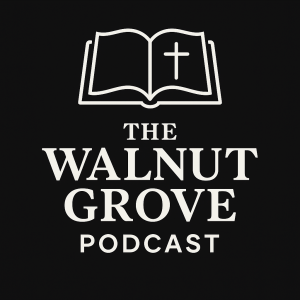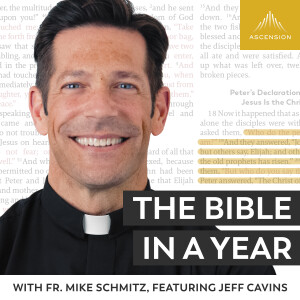

Join Tim and John as they talk about life and study John Chapter 19 Verses 1-42
Theme: https://uppbeat.io/t/northwestern/a-new-beginning
Transition Song: https://uppbeat.io/t/all-good-folks/
Introduction to John 19:1–42The Crucifixion: God's Power Revealed Through Suffering
John 19 is the heart of the Gospel’s passion narrative. It is a chapter of brutality and glory, mockery and majesty, suffering and sovereignty. Here, we see Jesus condemned, crucified, and buried. But John invites us to look deeper—to see not just the horror of Roman execution, but the eternal plan of God unfolding.
This is not merely a historical record of an unjust death. It is a divine drama in which the Lamb of God is lifted up, the Scriptures are fulfilled, and salvation is made available to all who believe.
Theological Significance:- Jesus as the Fulfillment of Prophecy
Nearly every moment in this chapter echoes Old Testament Scripture—from the crown of thorns to the casting of lots for His clothes. John consistently points us to fulfilled prophecy to remind us: this was God’s plan. - The Glory of the Cross
Paradoxically, John's Gospel portrays the crucifixion not as Jesus' humiliation, but as His glorification. This is the moment when He is “lifted up” (cf. John 3:14; 12:32)—a King enthroned, though His throne is a cross. - Substitutionary Sacrifice
From Barabbas going free, to Jesus’ declaration, “It is finished,” we are reminded that Jesus died in our place. His final breath is the beginning of our redemption.
- Jesus Is Flogged and Mocked (vv. 1–16)
– The soldiers crown Him with thorns and strike Him.
– Pilate presents Him to the crowd: “Behold the man!”
– Despite Pilate’s hesitation, Jesus is handed over. - The Crucifixion (vv. 17–30)
– Jesus carries His cross to Golgotha.
– He is crucified between two others, under a sign reading “King of the Jews.”
– As He dies, Jesus fulfills Scripture and commits His spirit. - The Burial (vv. 31–42)
– The soldiers confirm His death by piercing His side.
– Joseph of Arimathea and Nicodemus bury Him in a new tomb, wrapped in linen and spices.
- The Innocent Lamb – Behold the One who takes away the sin of the world.
- The King on the Cross – Jesus reigns even in death.
- The Finished Work – Nothing was left undone; our salvation is secure.
- The Seed That Falls to the Ground – The burial sets the stage for resurrection and life.
What does it mean that the King of Glory chose a cross instead of a throne?
This chapter invites us not only to observe Jesus' suffering—but to see the depth of His love, the magnitude of His obedience, and the power of God’s redemption.
Key Theme One: Jesus Is Sentenced to Die (John 19:1–16)When Innocence Meets Injustice, and Love Remains Silent
John 19 opens with a false trial descending into violence and political maneuvering, as Pilate tries to appease the crowd without condemning Jesus—yet ultimately fails. This passage is filled with tragedy, symbolism, and divine irony. Every lash of the whip, every cruel mockery, and every political compromise unfolds not outside of God’s plan, but within it.
1. Jesus Is Flogged and Mocked (vv. 1–3)“Then Pilate took Jesus and had Him flogged.”
- This is likely the lighter Roman scourging (compared to the brutal flagellation before crucifixion), meant to satisfy the crowd’s bloodlust without going to execution.
- Soldiers mock Him with a crown of thorns, a purple robe, and slaps—twisting royal symbols into instruments of ridicule.
- Irony runs deep:
The soldiers crown Him to humiliate—but in truth, they crown the King of Kings.
Theological Insight: Even in mockery, Jesus is revealed. He is King, not just of the Jews—but of all creation.
2. Pilate’s Struggle and Cowardice (vv. 4–7)“I find no guilt in Him.”
- Pilate publicly declares Jesus’ innocence multiple times.
- He presents Jesus to the crowd—wounded, humiliated—with the words:
“Behold the man!” (Ecce Homo)
A deeply ironic moment: this battered figure is the Second Adam, the perfect Man. - The Jewish leaders demand His death not on civil charges, but religious grounds:
“He made Himself the Son of God.”
Pilate is afraid—not only of the crowd, but of this mysterious man before him.
3. A Kingdom Not of This World (vv. 8–11)“You would have no authority over Me unless it had been given you from above.”
- Pilate questions Jesus again, this time privately and fearfully.
- Jesus remains mostly silent, but when He does speak, He asserts divine sovereignty:
Even Pilate’s power is granted by God. - Jesus is not the powerless victim—He is the willing Lamb, fully aware and in control.
Reflection: Christ’s silence is not weakness. It is strength under control, fulfilling Isaiah 53:7.
4. Political Pressure Overrules Justice (vv. 12–15)“If you release this man, you are not Caesar’s friend.”
- The crowd and the priests turn up the heat:
They manipulate Pilate politically, claiming allegiance to Caesar over Jesus. - Pilate caves. Though he wants to release Jesus, his desire to protect his position wins.
- He brings Jesus out and presents Him:
“Behold your King!”
The crowd responds with horror:
“We have no king but Caesar!”
This is an abandonment of Israel’s true hope—a tragic declaration of worldly loyalty.
Application Warning: When we fear losing status or approval, we may reject the very truth we claim to follow.
5. The Sentence Is Delivered (v. 16)“So he delivered Him over to them to be crucified.”
- Pilate surrenders the innocent to preserve peace.
- The verdict is not justice—but convenience.
- Jesus now begins the final steps to the cross.
Gospel Truth: The King is handed over… so we could be set free. Pilate's injustice becomes God's instrument of redemption.
Summary: The Innocent CondemnedCharacter
Action
Lesson
Jesus
Flogged, mocked, silent, sovereign
Love endures injustice. God’s will prevails.
Pilate
Wavers, delays, gives in
Knowing the truth means little without courage to stand for it.
Religious Leaders
Demand death, manipulate, betray their faith
Zeal without truth becomes violence.
The Crowd
Chooses Caesar
People often reject Christ to cling to power or comfort.
Application Questions
- Do I compromise truth when it's inconvenient?
- Have I crowned Jesus in my life—or do I still cling to lesser kings?
- When faced with fear or pressure, do I choose Christ—or self-preservation?
- Can I trust that God is at work—even in unjust or painful situations?
Love Lifted High
These verses take us to the center of salvation history—the cross. What appears to be the height of human cruelty is also the height of divine mercy. Jesus isn’t just dying for us—He’s revealing who He is through the way He dies. Every moment is rich with prophecy, purpose, and power.
1. The King Carries His Cross (v. 17)“So they took Jesus, and He went out, bearing His own cross…”
- Jesus carries the instrument of His own execution to Golgotha, the “Place of a Skull.”
- John doesn’t mention Simon of Cyrene (like the Synoptic Gospels)—instead, he emphasizes Jesus’ deliberate movement.
- He walks willingly into suffering.
Theological Insight: The Good Shepherd lays down His life. No one takes it from Him (John 10:18).
2. The King Is Lifted Up (vv. 18–22)“There they crucified Him… and with Him two others.”
- Jesus is crucified between two criminals, a fulfillment of Isaiah 53:12.
- Pilate places a sign above His head:
“Jesus of Nazareth, the King of the Jews”—written in three languages: Hebrew, Latin, and Greek. - The religious leaders protest the title, but Pilate stands firm.
Irony and Truth: They meant to mock, but the sign declares what John wants every reader to know—Jesus is the true King for all nations.
3. The Soldiers Fulfill Prophecy Unwittingly (vv. 23–24)“They divided His garments… but the tunic was seamless…”
- Roman soldiers gamble for Jesus’ clothes, fulfilling Psalm 22:18.
- The seamless tunic was likely priestly in nature—another picture of Christ’s role as our High Priest, stripped for our sake.
Reflection: Even in humiliation, Scripture is being fulfilled. God is sovereign even over injustice.
4. Jesus Cares for His Mother (vv. 25–27)“Woman, behold your son… Behold your mother.”
- From the cross, Jesus honors His mother by entrusting her to John, the beloved disciple.
- He models obedience to the fifth commandment (Exodus 20:12) even while suffering.
Human Insight: The One bearing the sins of the world also bears the grief of His mother.
This is the intersection of cosmic and personal suffering.
“I thirst.”
- Jesus, fully aware of prophecy, speaks to fulfill Scripture (Psalm 69:21).
- He is offered sour wine (vinegar), a bitter drink—a reminder of the cup of wrath He is drinking down to the dregs.
Theological Depth: Jesus thirsted physically so that we might never thirst spiritually again (John 4:13–14).
6. “It Is Finished” (v. 30)“He bowed His head and gave up His spirit.”
- Jesus’ final words—“It is finished” (tetelestai in Greek)—mean paid in full.
- This is not a cry of defeat, but of victory. The work of redemption is complete.
- He bows His head, not in death’s triumph, but in sovereign surrender.
Gospel Truth: The penalty for sin has been paid. The power of death is broken.
Nothing more needs to be added to His sacrifice.
Moment
Fulfillment
Meaning
Bearing the Cross
Isaiah 53:7
Jesus goes willingly to death
Crucified Among Criminals
Isaiah 53:12
Identified with the guilty
Garments Divided
Psalm 22:18
Sovereignty in suffering
“I thirst”
Psalm 69:21
Physical and spiritual agony
“It is finished”
Genesis to Revelation
The work of salvation is complete
Application Questions
- Do I recognize the cross not just as tragedy, but as triumph?
- What areas of my life need to rest in the truth that “it is finished”?
- Am I living like someone whose debt has been paid?
- Do I trust God’s sovereignty even when I can’t see it—like those watching the crucifixion?
Buried with Honor, Prepared for Glory
As the sun sets on the darkest day in history, Jesus’ body is removed from the cross and laid in a tomb. At first glance, this scene seems quiet, somber, and final. But John wants us to see more. Even in burial, God is at work, and the details whisper of resurrection, royalty, and reverence.
1. The Urgency of the Hour (vv. 31–33)“Because it was the day of Preparation…”
- The Jewish leaders ask Pilate to break the legs of those crucified—a method to hasten death—because Sabbath was approaching (a high holy day, due to Passover).
- The soldiers do so for the others, but when they come to Jesus, they find Him already dead.
Insight: Jesus had already given up His spirit voluntarily (v. 30). His life wasn’t taken—it was freely offered.
2. Pierced for Our Transgressions (v. 34)“One of the soldiers pierced His side with a spear…”
- Blood and water flow from His side—a sign of real death and, perhaps symbolically, the cleansing and life-giving power of Christ’s sacrifice (cf. 1 John 5:6).
- This act fulfills Zechariah 12:10:
“They will look on Him whom they have pierced.”
Theological Meaning: Even in death, Jesus' body gives evidence of His humanity and His divine purpose—a Savior fully man, fully God.
3. A Testimony Worth Writing Down (vv. 35–37)“He who saw it has borne witness…”
- John pauses the narrative to give eyewitness testimony. This isn’t legend or myth—it’s a historical event.
- He cites more prophecy (Psalm 34:20, Zechariah 12:10), reinforcing that every detail of Jesus’ death aligns with Scripture.
Faith Anchor: John wrote this so we might believe and know the cross is not just real—it is reliable.
4. Joseph and Nicodemus: Bold at Last (vv. 38–39)“Joseph of Arimathea… and Nicodemus… came bringing a mixture of myrrh and aloes…”
- Joseph was a secret disciple (out of fear), but now he steps forward, risking everything to give Jesus an honorable burial.
- Nicodemus—the same who came to Jesus at night (John 3)—brings 75 pounds of burial spices, a quantity fit for royalty.
Transformation: The cross has moved these once-fearful men to bold devotion. The power of Jesus' death brings courage, compassion, and clarity.
5. The Garden Tomb (vv. 40–42)“Now in the place where He was crucified there was a garden…”
- Jesus is wrapped in linen and laid in a new tomb, unused, symbolizing purity and distinction.
- A garden—echoing Eden—becomes the resting place for the Second Adam.
- This tomb is close by, and time is short—so He is buried there before sunset.
Symbolism: From a garden tomb, new life will spring. Death is not the end of the story.
Summary: A King’s BurialDetail
Fulfilled Prophecy
Meaning
Bones unbroken
Psalm 34:20
Jesus is the spotless Lamb
Pierced side
Zechariah 12:10
The Messiah bears our wounds
Myrrh and spices
Isaiah 53:9
He is buried with dignity
New tomb in a garden
John 20:15
Death will give way to resurrection
Application Questions
- Have I allowed the cross to move me from secrecy to bold faith, like Joseph and Nicodemus?
- Do I recognize that even in silence and stillness, God is preparing for resurrection?
- When all seems finished, do I still trust that God is not done?
- Am I living as someone who believes that Jesus' death really accomplished what He said: “It is finished”?
Love Fulfilled, Hope Buried, Glory Foreshadowed
John 19 is the most sobering chapter in the Gospel—and one of the most sacred in all of Scripture. It takes us from the injustice of a rigged trial to the cruelty of crucifixion and finally to the quiet dignity of burial. Yet through it all, this is not a tale of defeat, but of divine victory unfolding through suffering.
What We’ve Witnessed:- Jesus Condemned — Though innocent, He is scourged, mocked, and sentenced by the pressures of politics and the fear of man. Yet through it all, He remains in control, fulfilling the Father’s will.
- Jesus Crucified — The cross becomes not just a Roman tool of torture, but a throne of glory, where Jesus completes the work of redemption. His final words, “It is finished,” echo through eternity—declaring salvation accomplished.
- Jesus Buried — In a borrowed tomb, wrapped with royal myrrh and aloes, He is laid to rest. But even in burial, there is prophetic fulfillment, dignity, and divine purpose.
- Prophecy Fulfilled – Every step of John 19 is saturated with Scripture. Jesus is not a victim of chaos; He is the embodiment of the divine plan written long before.
- Sovereignty in Suffering – Jesus chooses the path of pain so we can walk the path of peace. Even in weakness, He is strong. Even in death, He reigns.
- Love Demonstrated – The cross is not just history—it is personal. It is the clearest demonstration of God’s love:
“Greater love has no one than this, that someone lay down his life for his friends.” (John 15:13) - A Tomb, Not a Finale – Jesus' burial sets the stage for what’s coming. The garden tomb, sealed and silent, is not the end—it is the threshold of resurrection.
- Do I believe the cross was for me?
- Do I live in the freedom of “It is finished”—or do I still strive to earn God’s love?
- Like Joseph and Nicodemus, has the death of Jesus moved me from fearful belief to bold devotion?
John 19 is not merely about what happened to Jesus.
It is about what He accomplished for us.
Through blood, bruises, and burial, the Lamb of God has made the way.
The curtain is torn. The price is paid. The tomb is sealed.
But the story is far from over…
The cross was the payment. The empty tomb will be the receipt.
More Episodes
All Episodes>>You may also like
Create Your Podcast In Minutes
- Full-featured podcast site
- Unlimited storage and bandwidth
- Comprehensive podcast stats
- Distribute to Apple Podcasts, Spotify, and more
- Make money with your podcast












